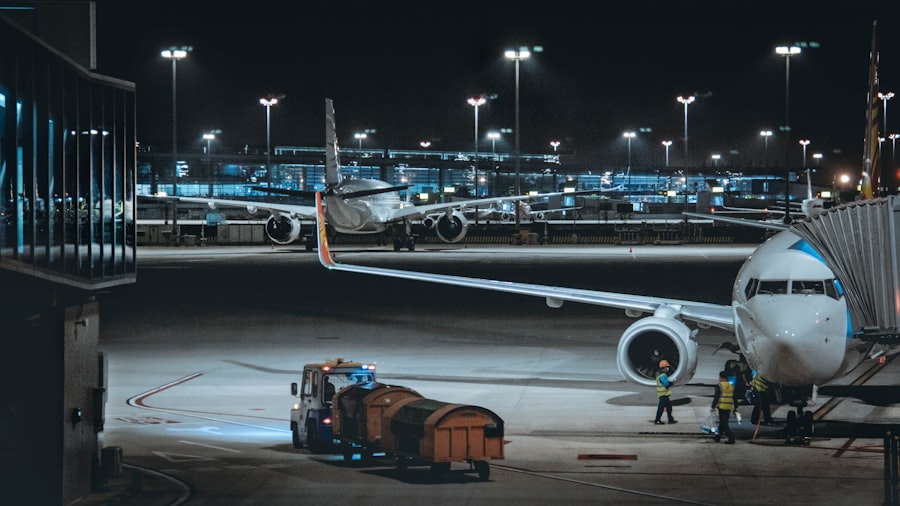The aviation industry has undergone a remarkable transformation over the past few decades, with advancements in technology playing a pivotal role in enhancing the efficiency and safety of air travel. One of the most significant developments in this realm is the ability to track plane movements with unprecedented accuracy and reliability. Tracking aircraft movements is not merely a matter of convenience; it is a fundamental aspect of modern aviation that ensures the safety of passengers, crew, and cargo.
The ability to monitor an aircraft’s position in real-time allows for better decision-making by air traffic controllers, airlines, and other stakeholders involved in the aviation ecosystem. Historically, tracking aircraft relied on rudimentary methods such as radar and visual observation. However, as air traffic has increased exponentially, these methods have proven insufficient to manage the complexities of modern air travel.
Today, a combination of satellite technology, ground-based radar systems, and advanced communication networks work in concert to provide comprehensive tracking capabilities. This evolution has not only improved operational efficiency but has also paved the way for innovations that enhance the overall flying experience for passengers.
Key Takeaways
- Plane movements can be tracked using various technologies to ensure safety and security.
- Efficient plane tracking is crucial for real-time monitoring and data analysis.
- Technologies such as radar, GPS, and ADS-B are used for tracking plane movements.
- Real-time monitoring and data analysis help in improving air traffic control systems.
- Future developments in plane tracking technology aim to enhance safety, security, and efficiency in air travel.
The Importance of Efficient Plane Tracking
Efficient plane tracking is crucial for several reasons, primarily revolving around safety, operational efficiency, and environmental considerations. The safety of passengers and crew is paramount in aviation, and accurate tracking systems play a vital role in preventing accidents and ensuring timely responses to emergencies. For instance, in the event of an aircraft deviation from its planned route or an unexpected change in weather conditions, real-time tracking allows air traffic controllers to make informed decisions quickly.
This capability can be the difference between averting a potential disaster and facing catastrophic consequences. Moreover, efficient tracking contributes significantly to operational efficiency within the aviation sector. Airlines can optimize their flight schedules, reduce delays, and improve turnaround times by having access to real-time data on aircraft movements.
This efficiency translates into cost savings for airlines, which can then be passed on to consumers in the form of lower ticket prices or enhanced services. Additionally, efficient tracking systems facilitate better coordination between various stakeholders in the aviation industry, including airports, airlines, and ground services, leading to a more streamlined travel experience for passengers.
Technologies for Tracking Plane Movements

The technologies employed for tracking plane movements have evolved dramatically over the years. One of the most significant advancements is the use of Automatic Dependent Surveillance–Broadcast (ADS-B), which allows aircraft to determine their position using satellite navigation and periodically broadcast it to ground stations and other aircraft. This technology enhances situational awareness for pilots and air traffic controllers alike, providing a more comprehensive picture of air traffic in real-time.
In addition to ADS-B, traditional radar systems continue to play a crucial role in tracking aircraft movements. Ground-based radar systems can detect aircraft within a certain range and provide critical information about their altitude, speed, and heading. However, radar has limitations, particularly over oceans or remote areas where ground stations are sparse.
Satellite-based tracking systems have emerged as a solution to this challenge, offering global coverage and enabling tracking even in regions where radar is unavailable. These technologies work together to create a robust framework for monitoring aircraft movements across various environments.
Real-time Monitoring and Data Analysis
| Metrics | Value |
|---|---|
| Number of real-time data sources | 15 |
| Real-time data processing speed | 5000 records/second |
| Percentage of data accuracy | 98% |
| Number of active monitoring alerts | 10 |
Real-time monitoring of aircraft movements generates vast amounts of data that can be analyzed for various purposes. This data encompasses not only the geographical position of an aircraft but also its speed, altitude, and even engine performance metrics. By leveraging advanced data analytics tools, airlines and air traffic control authorities can gain insights into flight patterns, operational efficiencies, and potential areas for improvement.
For example, data analysis can reveal trends in flight delays caused by specific routes or weather conditions. By identifying these patterns, airlines can adjust their schedules or implement contingency plans to mitigate delays. Furthermore, real-time data analysis can enhance predictive maintenance strategies for aircraft.
By monitoring engine performance and other critical systems during flight, airlines can anticipate maintenance needs before they become critical issues, thereby reducing downtime and improving overall fleet reliability.
Improving Air Traffic Control Systems
The integration of advanced tracking technologies has led to significant improvements in air traffic control (ATC) systems worldwide. Traditional ATC relied heavily on voice communication between pilots and controllers, which could lead to misunderstandings or delays in relaying critical information. With modern tracking technologies like ADS-B and satellite-based systems, controllers can visualize aircraft movements on sophisticated displays that provide real-time data about each flight’s status.
This enhanced situational awareness allows air traffic controllers to manage airspace more effectively. For instance, they can implement more efficient separation standards between aircraft, reducing the minimum distance required during takeoff and landing phases without compromising safety. Additionally, improved tracking capabilities enable better management of congested airspace around major airports, allowing for smoother arrivals and departures while minimizing delays.
Enhancing Safety and Security Measures

Safety and security are paramount concerns in aviation, and effective plane tracking plays a crucial role in addressing these issues. The ability to monitor an aircraft’s movements in real-time allows authorities to respond swiftly to any anomalies or emergencies that may arise during flight. For instance, if an aircraft deviates from its planned route or experiences technical difficulties, air traffic controllers can quickly assess the situation and coordinate appropriate responses.
Moreover, tracking technologies contribute significantly to enhancing security measures within the aviation sector. In recent years, there has been an increased focus on preventing unauthorized access to aircraft or potential threats posed by individuals on board. Real-time tracking systems can help identify suspicious behavior or unauthorized movements around airports or within restricted airspace.
By integrating tracking data with security protocols, authorities can enhance their ability to detect and respond to potential threats before they escalate into serious incidents.
Optimizing Flight Routes and Fuel Consumption
One of the most significant benefits of advanced plane tracking technologies is their ability to optimize flight routes and reduce fuel consumption. Airlines are under constant pressure to minimize operational costs while maintaining high levels of service quality. By utilizing real-time tracking data, airlines can make informed decisions about flight paths that take into account current weather conditions, air traffic congestion, and other factors that may impact fuel efficiency.
For example, if a flight encounters unexpected turbulence or adverse weather conditions along its planned route, pilots can use real-time data to adjust their course accordingly. This flexibility not only enhances passenger comfort but also contributes to fuel savings by avoiding unnecessary detours or altitude changes that could lead to increased fuel consumption. Additionally, airlines can analyze historical flight data to identify optimal routes that consistently yield lower fuel usage over time.
Future Developments in Plane Tracking Technology
As technology continues to advance at a rapid pace, the future of plane tracking holds exciting possibilities that could further revolutionize the aviation industry. One area of development is the integration of artificial intelligence (AI) into tracking systems. AI algorithms can analyze vast amounts of data from multiple sources to predict potential issues before they arise, allowing for proactive measures that enhance safety and efficiency.
Another promising avenue is the development of more sophisticated satellite-based tracking systems that offer even greater accuracy and coverage than current technologies. Innovations such as space-based radar could provide continuous monitoring capabilities over remote areas where traditional radar systems are ineffective. Furthermore, advancements in communication technologies may enable seamless data sharing between aircraft and ground control stations, facilitating real-time updates on flight status and environmental conditions.
In conclusion, the evolution of plane tracking technologies has transformed the aviation landscape by enhancing safety measures, improving operational efficiency, and optimizing resource utilization. As we look ahead to future developments in this field, it is clear that continued innovation will play a crucial role in shaping the future of air travel for generations to come.


